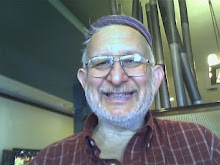- Judaism or death - spiritual or physical.
- Recovery or death: I am either in my recovery or in my adddiction.
In Jewish language we say this as (from Ma'ariv - the evening service):
ki hem chayyeinu v'orech yameinu uvahem nehgeh yomam va-lailahSuch a rationale has to be simple, powerful and compelling. Like the 12 Steps, it must come equipped with:
For the Torah is our life and the length of our days,
and that's why we need to meditate upon it and study it day and night
• a description of the fundamental problem of existence
• a description of a solution. There is hope of healing/recovery!
• an action plan, a method of salvation/healing/recovery, like the 12 steps.
A benefit of such a rationale is that Jews and non-Jews would know clearly whether this path is for them. As much as I love my tribal Jewish identity by birth (over which I had no control), ultimately we are all Jews by choice.This is the language of Rabbi Harold Schulweis. It makes no difference if I were born Jewish or not.
Not everyone has to be Jewish (my holy stepsons accuse me - with justification - of seeing the entire world through Jewish-colored glasses). There are many paths up the mountain. The peak is the same for all spiritual traditions. Each path up the mountain appeals to a different (spiritual) temperament. In Chasidic terms, each human temperament (neshamah) requires a different sort of rebbe/teacher.
Judaism is a lot of different things: a tribal identity, a culture, a relationship to the State of Israel, a spiritual path. Here I want to focus on Judaism as a spiritual path. I am not sure I can tell you the difference between spirituality and religion. But empirically I can tell you that Americans respond a whole lot better to the word spirituality than to the word religion.
Before I share with you my back-of-the-match-book rationale for Judaism as a spiritual path, I'd like for us to take a look at the rationale for the 12 Steps, one of the most popular spiritual paths in America. Remember: the back-of-the-match-book has to describe the problem, the solution and a path for getting there. For 12 step programs (e.g. Alcoholics Anonymous, Codependents Anonymous), the succinct match-book-cover is the 12 Steps.
The Problem: I am an addict, I know it's going to kill me eventually, and I am powerless over my addiction (Step 1).
The Solution: There is a solution, it's called recovery. In 12 step program language: I can't heal my self, God can, but only if I let God heal me.
The Path for getting there: The 12 Steps, which I summarize as follows:
- Steps 1, 2, 3: I can't, God can, if I let God. Turning it (my life and will) over to the care of God, as I understand God.
- Steps 4, 5, 6, 7: Character Inventory. Confession of inventory to God, self and other human beings. Being willing to let God remove my defects of character, and humbly asking God to do so.
- Steps 8, 9, 10: Making amends (roughly teshuvah in Hebrew) to all those I have harmed, including myself!
- Step 11: Aligning myself with God's will for me. Developing a conscious relationship with God, as I understand God, praying only for the knowledge of God's will for me and the power to carry it out.
- Step 12: The Tzaddik/Saint/Boddhisattva step of service to others. Having had a spiritual awakening (for which we are grateful), we try to carry the message to those who still suffer from our addiction, and to practice these principles in all our affairs (teaching by example, walking the talk).

No comments:
Post a Comment